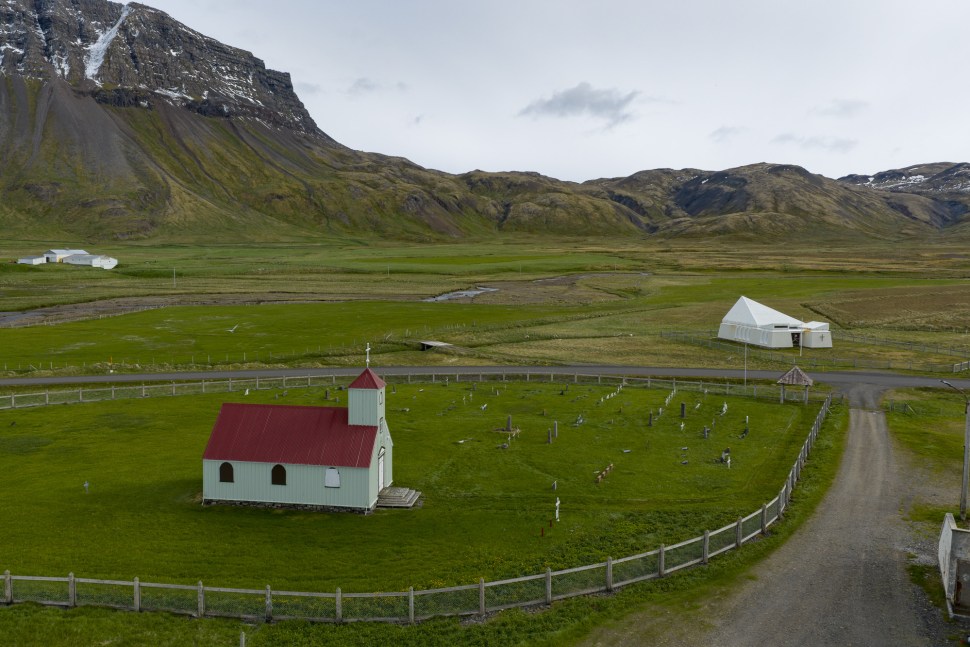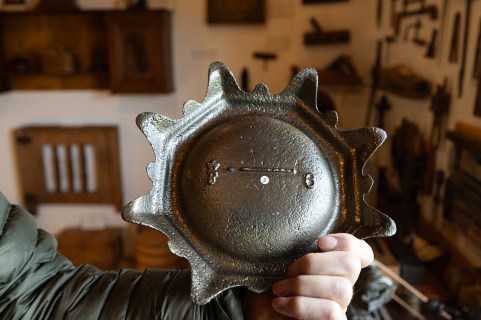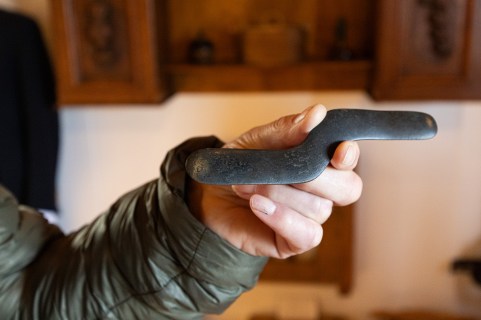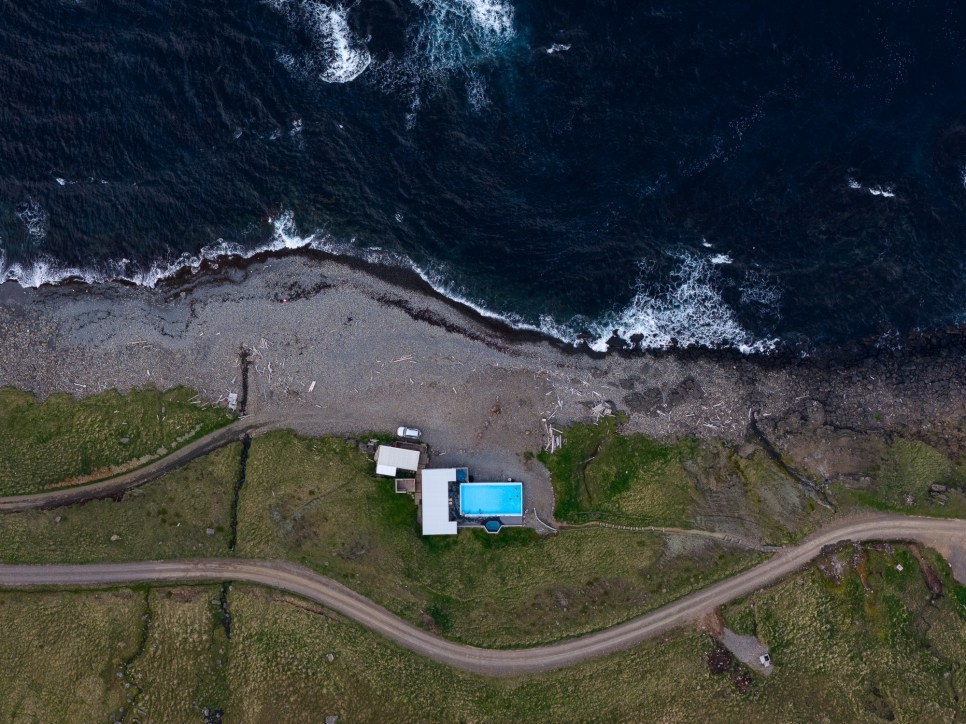The Strandir region doesn’t give up its secrets easily. Maybe it’s the geography — so remote that stories take longer to travel. Maybe it’s just the way things work out here. Somewhere between the silence and the sea spray lies Trékyllisvík, a tiny cove between Djúpavík and Norðurfjörður, in Árneshreppur — the northernmost part of Iceland’s northernmost municipality. A handful of houses dot the shoreline, but there’s no one outside, just a gang of screaming arctic terns.
This is where the Westfjords’ witch-hunting craze reportedly began — three witches were burned here sometime in the 17th century. That bit of dark history clings to the place. There’s a school. A small museum. But the biggest curiosity? Two churches facing each other across the road: Árneskirkja and Árneskirkja II.
There’s no priest in the area anymore, and no one can quite explain why there are two churches — a mystery I’m hoping to crack someday. “I was confirmed in one, but we got married in the other,” one local tells me. Beyond that, the answer’s lost to time.


Photo by Art Bicnick
Grandpa’s little museum
In the middle of Trékyllisvík stands Kört, a small museum guarded by a tiny knee-height gate. A sign at the door says you need to ring the bell to enter. I press it, and a teenage girl emerges from the house behind to let me in. I ask if she can show us around and tell us a bit about the museum’s history. Slightly confused, she replies, “Let me call my grandpa.”
“But it’s really the view that steals the show: a dramatic cliff on one side, and an endless stretch of ocean on the other.”
A few minutes later, Valgeir Benediktsson, the grandfather and the museum’s founder, appears. Valgeir is a farmer who has spent years collecting crafts and everyday objects from the area: old tools, textiles, items made from stone and driftwood. Over time, his collection started drawing more and more attention from people passing by. So in 1996, he built another house on his land to give the museum a dedicated space.
One of the reasons Kört exists is to preserve “the stories of people who are now dead that have done something interesting or lived an unusual life,” says Valgeir, matter-of-factly.
He shows me around with his granddaughter, who is patiently translating. He tells me about a fisherman who had 18 children, a man who used his tobacco case to forecast the weather, and a walrus tooth believed to be between 10,000 and 12,000 years old — he had it inspected.
Valgeir says he’s constantly changing his favourite item in the collection, but for now, this might be this beautiful askur — a traditional Icelandic wooden bowl with a lid, used as a container for food, more like an old-school lunchbox. In turf houses, which were very small, there was no space for a table, so everyone in the household had their own askur. They went out of use as soon as proper houses were built in the 20th century. “It’s a bit fascinating that it’s preserved,” Valgeir says. “Because it’s so whole and nice. Usually, these things get damaged.”
He then shows me a candleholder carved from stone that dates back a few hundred years. You could pour some lýsi into it and light it up. “The wick was made from cotton grass. Lights like these were not used in Iceland after 1400,” Valgeir explains.
We look around the museum a bit more — it also sells knitwear made by locals and some of Valgeir’s own woodwork, including carved birds common to the area. Then we say goodbye. As soon as we step outside, the granddaughter pulls the flag on the flagpole down — enough curious visitors for today.
Krossnes, finally
Driving through this beautiful, untouched landscape, it’s hard to imagine what could make the day better. But there’s one thing that can: a visit to a pool. And not just any pool — this one has been on my list since 2022, when I interviewed Jón Karl Helgason, director of Sundlaugasögur (Swimming Pool Stories), a documentary about Iceland’s bathing culture.
For the film, Jón travelled around the country multiple times, visiting every single pool. When I asked him which one stood out, he didn’t hesitate: “Krossnes is beautiful. When you’re in there, you can see the horizon, the ocean — and feel like you’re alone in the world.”
Krossneslaug lies at the very end of the road. If you want to continue north from here, you’ll need to either walk, drive a jeep, which will only take you a couple of fjords more north, or go back and take a boat from Norðurfjörður — the last place nearby where you can stock up on food or grab a bite at the small restaurant, now run by Hotel Djúpavík. Last year, I almost reached the goal of visiting this pool — only to find that the pool was drained when I arrived. (A quick note: there’s a mud football championship in the area every Verslunarmannahelgi (always the first weekend of August), and after the matches, muddy footballers head straight to the pool to relax. This usually means a day or two of closure for cleaning and maintenance.)
This time, luck is on my side. The pool is open, and a friendly Kristín greets me at the cash register. She spent the last few winters in Austria, but Strandir somehow pulled her back. “I heard there are young farmers who recently moved to the area. Do you happen to know them?” I ask. Kristín laughs, “Oh yeah, those are my parents.”
Krossneslaug turned 70 years old last year. For decades, it has been a vital part of the region — a place where local children learned to swim. These days, two hot tubs warmer than the pool have been added. But it’s really the view that steals the show: a dramatic cliff on one side, and an endless stretch of ocean on the other.
There are a few people in the pool, and we exchange some small talk. One of them teases another, saying that only crazy people live here. I’m not sure about that. But if “crazy” means soaking in the pool with this view every day, they’re not mad at all.
This is the third piece in a series of articles from our recent trip to Strandir. Thanks to Hotel Djúpavik for the accommodation and Go Car Rental for the wheels. Book your car at gocarrental.is.



